#and started sdf macross
Explore tagged Tumblr posts
Text
really funny ending: next project's singers is a guy/boyband (id kill myself. but it could be really fun if the pilot is a woman)
reasonable ending: it's gonna be another Unit thing but probably a Bit Smaller, just to differenate itself from Walkure and probably slightly easier from a story perspective
just give me a diva with a strong voice and a pretty design and i will literally face whatever nonsense you guys got cooking in the tank as you always are.
NEW MACROSS PROJECT INFOMATION POTENIALLY INCOMIGN?
#nova's rambling again#i should really watch more macross#i did start 7 but maybe i should watch SDF
1 note
·
View note
Text
Macross 7 is very silly, but it can definitely be brutal when it wants to. Kind of like ZZ Gundam in that respect.
Though I guess the original SDF Macross also seemed like a fun space adventure, up until the Zentraedi fleet started targeting Earth…
5 notes
·
View notes
Text
OK we have to talk about Macross toys again
I'm in trouble
A couple years ago on a lark I bought the Hi-Metal R Roy Focker VF-0S. I picked that one because I thought it had the best color scheme and because you could see the skull and crossbones in every transformation mode.
But then further research indicated that a VF-1S would have been more of a "classic" or quintessential purchase since it's from the original SDF Macross/Robotech
Further research indicated the Bandai DX VF-1S was the best one to buy, but it was very expensive
Then ThreeZero released a VF-1S that I bought, and I was pleased with it, but it just made me want the DX more
Then I bought the DX
Now I have a problem. Right now I have three Macross toys (well, two Macross and one Robotech, the ThreeZero has Robotech branding). I had thought I would continue acquiring examples of Roy Focker machines in various scales, like the Hi-Metal R VF-1S, the old Yamato VF-1S, maybe an Arcadia VF-0 if the right one showed up
But then I started watching the show and looking into some of the other stuff out there and it seems like Hikaru's VF-1J would be kind of the quintessential Valkyrie, and also the VE-1 Elintseeker and VF-1D are pretty cool
Now what I could do is sell everything but the DX and force myself just to have one Macross toy. It would be against my instincts, but possibly for the best
Or just commit to only buying Roy Focker machines
2 notes
·
View notes
Text
WIP Word Game!
RULES: You will be given a word. Then you will share one sentence/excerpt from your wip(s) that starts with each letter of your word.
I was given the word "ANGER," courtesy of @musical-chick-13. Yay! I love being tagged in things! Excerpts from Chapter 2 of my massive SDF Macross AU.
A: A lavender turtleneck, a white pencil skirt, and Minmei’s little hands fastening the golden buttons of her jacket. “Yes Auntie?” Minmei’s eyes were bright with nerves–her smile was stiff as her collar. N: “No, you’re right, I do,” A weak smile was all Feichun could manage. Her beautiful son. Dead, surely, but at the same time, wouldn’t she know, if she knew? “You know he didn’t get his wild ideas from his father,” She could feel herself rambling, scrambling to hold herself together. G: Global had hardly suppressed his mirth. Misa had barely suppressed her rage. E: Even as a little girl she’d never attempted to call him by his Christian name. Far too much the military scion, never far from her father’s side. And she was hardly going to attempt it now that he was her commanding officer. R: Don't actually have one for R, but my beneficent friend allowed me to choose a sentence with an r in the first word! Cigarettes were in much greater supply aboard the SDF than pipe tobacco; he’d pretend he was showing frugality, not desperation.
Handing out absolute-no-pressure tags to @boymagicalgirl @carolinanadeau and anyone else who might want to do it. Your word, should you choose to accept it, is SHEAR
2 notes
·
View notes
Text
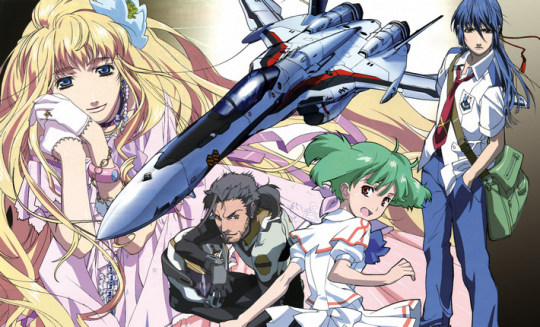
I started watching Macross Frontier last night. I'm already hooked, right off the bat.
I've picked up enough background information to know that Alto is going to be an important character, and he's definitely giving off "main character" vibes. But I like how everyone's giving him shit about being too pretty.
And I'm assuming Ranka is going to be important, too... But it's not obvious how, yet. Love interest? Musical talent? Fighter ace? All of the above?
The idol we've been introduced to - Sheryl Nome - seems like kind of an asshole so far.
The animation is looking very nice. It's clearly updated and computer-assisted... But it doesn't have that ugly/flat look to it like the mecha in Macross Zero did. And the battles I've seen so far were spectacular.
What's up with the enemies? They look like bugs. I'll be curious to see where this goes... Is there intelligence behind them, or are they just monsters?
I'm also loving some of the easter-eggs and homages to earlier works...

When we first see Alto and his classmates they're practicing for some aerobatic performance and doing the flying-hand thing we saw Isamu doing back in Macross Plus.

Sheryl starts her concert by demanding that everyone "listen to my song" just like Basara did in Macross 7. And there's some Fire Bomber music playing on a car radio later on.

There's a dramatic sequence where Alto saves Ranka from the aliens and it looks a lot like when Hikaru saves Minmay from the Zentradi back in SDF Macross.
I'm sure there's probably more that a casual fan like myself missed... But I was still tickled when I recognized these.
2 notes
·
View notes
Note
What's the best watch order for macross for someone who's always meant to check it out out but never has, but now wants to but doesn't know where to start?
If by “best order” you mean you want to know how to watch each series so that you can go into each one understanding the connections to the other parts of the franchise, then it would absolutely be chronological order.
This would be SDF Macross > Macross Plus > Macross 7 > Macross Zero > Macross Frontier > Macross Delta.
When watching SDF, you’ll want to watch the movie Do You Remember Love? right after and the short OVA Flashback 2012 sometime before Delta.
Macross Plus has two versions, the OVA and the movie versions. You can watch either to experience the story. The OVA has more content while the movie is a shortened edit of the OVA, but has some original footage not seen in the OVA.
Macross 7 is long and while you’re watching it, you might want to watch the OVAs Macross 7 Plus and Macross 7 Encore. These take place during the series. Plus is a bunch of really small shorts while Encore is basically just three more episodes. And there’s the movie and Dynamite 7 OVA, which are also not super important so you can watch them whenever, but you might want to at least watch Dynamite 7 before Frontier.
Macross Zero is just an OVA series, but you’ll probably want to watch it before Frontier.
Frontier has two movies that you’ll want to watch because they seem to supersede the canon of the TV anime (still watch the anime too though since it has a lot of context for the movies). Labyrinth of Time is a short film that was recently released for Frontier over a decade after the last movie and you’ll definitely want to watch it sometime after movie 2 since it provides some closure. There’s also the FB 7 OVA which is really just a summary of Macross 7 told to the Frontier cast, but it has a new song and new footage of the characters.
Delta has two movies, one that tries to supersede the canon of the anime like the Frontier movies that reuses a lot of footage from the anime (but again, still watch the anime) and an original movie that definitively ends Delta. There are also some unimportant comedy OVAs.
There’s also Macross II, but it’s not canon so if you want to watch it, you can anytime after finishing SDF.
22 notes
·
View notes
Text
Animation Night 168: when Anno was young...
Animation Night has been getting kind of short lately, huh? Gone are the days when we'd marathon three films in a night... for now. Next week is Animation Night 169, and @mogsk has been helping me cook up quite a program to act as a sequel to Animation Night 69. It's time to find out just how much Twitch will let me get away with.

But what about tonight? Well, tonight I figure since we've been talking about Anno this week, it might be fun to put a short program together to show some of his earlier works - as an animator. Truly long-time viewers might remember watching Royal Space Force: The Wings of Honneamise and Gunbuster all the way back on Animation Night 29. But this isn't exactly a reprise of that. We'll revisit Gunbuster on another day. Tonight the subject will be Metal Skin Panic: Madox-01 and Royal Space Force: The Wings of Honneamise.
So here's a brief timeline (largely leaning on SteveM's video here lol). Anno's work on the Daicon III film got him a foot in the door in the industry by impressing Studio Nue enough to invite the Daicon III team to work on Macross. Nue were also in large part fans turned animators, many of them Gundam doujinshi artists. Anno joined what became known as the 'mecha unit' at Artland, working alongside the legendary Ichirō Itano - where he was known for walking around barefoot and talking loudly to himself. A couple of years after Daicon III, the Daicon team reassembled to create a followup film, a lavish effort packed with a ludicrous density of pop-culture references.

Not long after this... Anno dropped out of university, and started bouncing between animation studios in Tokyo. The next big break came when he applied to work on Miyazaki's Nausicaa, a production which was rapidly transforming the outsourcing-oriented studio Topcraft into a gathering of some of the best animators in the business. At Topcraft, Anno's reputation was 'the primal man', sleeping under his desk with the cockroaches and not wearing shoes. But despite his inexperience, he made a good impression on Miyazaki, who assigned him the crucial finale cuts of the God Warrior.
Here we see what is sometimes called the 'Anno explosion', where the laser sweeps across and a massive explosion follows after a beat. Anno was able to handle the complex shading and multiple layers with aplomb...

...if not entirely on schedule. (One anecdote has that he tried to use his work on this sequence to pick up women. Which, to be fair...)
So in the mid 80s, Anno has established himself as a skilled mecha animator who can handle some ludicrously technical scenes. Besides Nausicaa and Macross, you will see him in Megazone 23 Part I, Giant Robo: The Animation, Baoh, Birth - and even Grave of the Fireflies. Any time you wanted mechanical animation or explosions, Anno was definitely a guy to get on the phone. And of course one of his most significant projects was on SDF Macross: Do You Remember Love? where he animated... you guessed it, lots of missiles and explosions.
With all this experience under his belt, Anno was almost ready to return to the newly founded Gainax - what had been Daicon Film. But first - lets check out Metal Skin Panic! MADOX-01. This OVA, made at AIC and Artmic - who made so many of the classic OVAs from this period, it's nuts - was the directorial debut of Shinji Aramaki, whose later CG films we covered back on Animation Night 152. Even back in 1987, Aramaki's love of intricate mechanical detail was on full display - and luckily Anno was on hand to make that vision work, along with the even younger 14-year-old prodigy Kōji Akimoto. (I'm not entirely sure what became of Akimoto. He only has one other anime credit, much later.)

Anno's scenes here prefigure the later similar hyper-detailed mechanical animation in works like Patlabor 2. But what's this OVA actually about? Well, it's a pretty simple story: a mechanic gets trapped inside a mecha suit, and accidentally ends up on a rampage as he's chased by the military (remind you of Roujin Z? or Stink Bomb in Memories?), hoping to unite with his girlfriend Shiori. Ultimately he ends up in a confrontation with an American soldier Lieutenant Kilgore. They fight! Really, we're here for the animation.
So, that brings us to Royal Space Force. The origin is kinda messy. To make a long story short, Daicon Film approached Bandai, hoping to make an OVA based on new Gundam kits. Bandai (and more specifically Shigeru Watanabe) said no to Gundam, but they were interested in this idea for a scifi OVA - and they'd drop them a cool three and a half million dollars to make a film to rival Nausicaa. (Apparently Mamoru Oshii's approval played a big part in that).
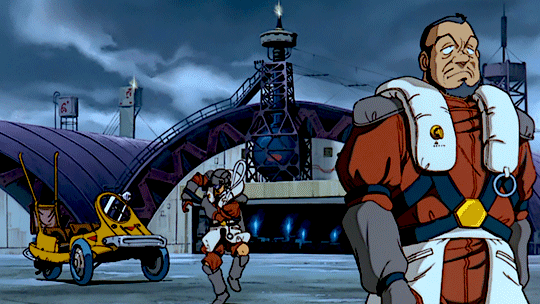
So Royal Space Force, what a film. There truly isn't anything quite like it, either in Gainax's oeuvre or anime at large. The closest thing I could compare it to might be the near-future anime series Planetes, which similarly focuses on realistic spaceflight in the context of war and geopolitics - but the tone of these two stories is markedly different. Of all things, it actually most makes me think of the works of Le Guin.
Honneamise is set on a fictional world vaguely resembling eartly 20th Century Earth, in which a country embroiled in war is putting together its world's first, threadbare space programme. It follows aspiring astronaut Shirotsugh Ladatt, who missed his chance to be a pilot and ended up in the sideshow space programme. But he meets a religious girl named Riquinni Nonderaiko who convinces him of the potential of spaceflight in bringing peace to the world.
But this idealism clashes with the reality of a world where the space programme is viewed cynically, a means to an end, with protestors questioning the cost of it and the higherups seeing the rocket launch merely as a means to set up an ambush against their enemies. Shirotsugh increasingly doubts whether the space programme is worthwhile at all. And he himself is definitely not a fully sympathetic protagonist; in one particularly uncomfortable scene he attempts to rape Riquinni (which in its framing reminds me of a similar moment with Shevek in The Dispossessed).

The film is as much as anything an insane work of worldbuilding, full of constructed cultures and small details that sit just a little askew of Earth while still feeling incredibly grounded. The animation in this film is fucking insane - not just Anno's incredible rocket launch and flight sequences, based on a research trip to the States where he watched the Shuttle go up for real - but throughout, in its character animation, it anticipates the 90s 'realist' approach to stylisation. It's just full of loving detail, wordlessly conveying so much about its setting.
Of course, such an ambitious film faced a troubled production. Between the inexperience of Daicon Film Gainax and the difference between what this film was going for and what everything else was going for, and production meddling... it was a mess. Big name composer Ryuichi Sakamoto was pulled in to score the film, won over by its storyboards, but ended up clashing over the timing of scenes, and in the end his score was chopped up and rearranged.
And for their part, Bandai started getting antsy and attempted to impose changes, like insisting on tacking on the subtitle 'The Wings of Honneamise'. They wanted to cut the runtime, cut elements that didn't have toy potential, and so on. They wanted something that would sell toys... and got a deliberately slow, moody art film that leans heavily on nonverbal storytelling.

So it's a weird one... and it didn't sell in its theatrical run. But you know, all those elements that made it a hard sell at first are a perfect recipe for 'cult classic', and for that reason, Honneamise is still remembered today.
In any case, back to Anno. He delivered the most impressive animation of his career. The rocket launch in meticulous detail of course, but equally scenes of planes to rival any in Miyazaki's films (or The Cockpit [AN146]). Of course, he didn't carry it alone! The great realist Toshiyuki Inoue, who'd later be famous for his work at Production I.G. such as Ghost in the Shell, was on it, working for example on astonishingly busy crowd scenes which apparently took a full month to animate. And animators like Fumio Iida, Nobuteru Yuki and Noriasu Yamauchi, brought some of the best work they'd ever done.
All in all, there's nothing quite like Royal Space Force, before or since. So I'm really looking forward to seeing it again.
Animation Night 168 will go live shortly; films will begin at 11pm UK time and continue to about 2am UK time. (Apologies it's so late once more, my sleep is proving troublesome to shift.) We will as usual be at twitch.tv/canmom. I hope to see you there, it's gonna be a real sakuga feast tonight!!
#animation night#anime#animation#hideaki anno#royal space force: the wings of honneamise#metal skin panic: madox-01
24 notes
·
View notes
Text
Narumayo Week Day 6: Robotech AU
"How… how could you say that to me?"
Nick blinks. "I thought you'd be flattered! Lynn Minmei is the idol of the entire SDF-1!"
"You really think I'm that annoying?" Maya's face screws up and tears start to wet her cheeks. "I know way more than three songs, Nick!!"
"Seriously, this is the first I'm hearing that you aren't a Minmei fan."
"They've been playing her non-stop since the Miss Macross competition! Which I only didn't enter because we were busy with a case!"
He puts a hand on top of her head. "You would've won, Maya. I know it."
---
@narumayoweek2024
5 notes
·
View notes
Text
Requested by Feyzer
The Decisive Battle: The Thunderous Lynx against the Hell Brigade

This...this was the exact moment, near inches from the capital of Finland that if it weren't for the bold and critical actions brought about by Finland's metal hero Fulynx...
...Helsinki would've become a scorched graveyard by this brigade of undead monsters and their two-legged living base...
This was a joy to draw from stage to stage, starting with the challenge of making my take on Feyzer's Fulynx, where not only I had to follow on the original design concept he had but also taking inspiration from, quite fittingly the same source Fulynx was inspired on: Battletech
Which brought me to one particular edition of that TRPG that I could draw inspiration from, the Japanese Edition Rule Book featuring Mech redesigns made by Studio Nue of SDF Macross fame!
Next up was coming up with a baddie Fulynx could blow up and coincidentally during that week I've been revisiting the underrated horror cartoon series Inhumanoids where I borrowed inspiration from the undead horror himself D'Compose.
And lastly, the background where I think I made my best sunset so far, plus the other details like the famous water tower of Helsinki and some bits of forest you can see below, I'm quite happy with how it came about in the end ^u^
2/4 Commissioned Art
=Feyzer's DA link=
#artists on tumblr#commission art#commissioned art#fanart#gt/tiny#scifi#mecha art#mecha#giant robot#daikaiju#kaiju#kaiju art#finishing blow#sunset#Lynx#others ocs#oc art#battletech#studio nue#inhumanoids#D'compose
14 notes
·
View notes
Text
Macross Zero Gets Me To Blog About Macross Here and It’s Honestly a Surprise How Little I've Done That Considering How Much I Like Macross as a Whole
12 Days of Aniblogging 2023, Day 7
What is Macross fundamentally about? Why is anyone drawn to this mecha franchise that’s played second fiddle to Gundam for nearly every step of its existence? The classic answer is the interplay between idols, mecha, and romance that Macross offers, with each iteration tweaking the balance to new results. But I think this viewpoint misses one of the most unique aspects of the original Super Dimension Fortress Macross anime, which is the culture war at the center of everything. The Zentradi are an alien race raised solely for battle, which gives them overwhelming firepower but leaves them deeply vulnerable to soft power. It's not the cool transforming ships that win the war, but romance and pop music and consumerist culture and pluralism and sickening amounts of gender. The Zentradi are literally humanized by the end of the show, as the nine-episode epilogue of SDF Macross is about the surviving humans and Zentradi trying to coexist in a new society built on the ruins of Earth, and the conflicts that arise from assimilation. For the most part it’s handled shockingly well for a 40-year-old show.

you bet your ass I'm just using macross baby throw instead of looking for a more relevant screenshot
Most of the later Macross installments downplay the contact narrative aspect, moving the continuity forwards and introducing new enemies that are either comically evil or uncaring hive-minds. And that’s fine! Instead, we get the insanity of Fire Bomber in Macross 7, and some of the best mechanical animation ever put to cel in Macross Plus. But as Macross Frontier and Delta go all-in on idols and sell ungodly amounts of CDs, eventually you start to feel like something’s missing.
Macross Zero is the one series I hadn’t gotten around to until this year. The only things I knew going in were that it was a relic of the early digital era, the first Macross to use CG for the dogfights, and focused primarily on native Pacific islanders. This all had me a bit worried! But what the setting actually entails is contact at the forefront of a Macross series again.
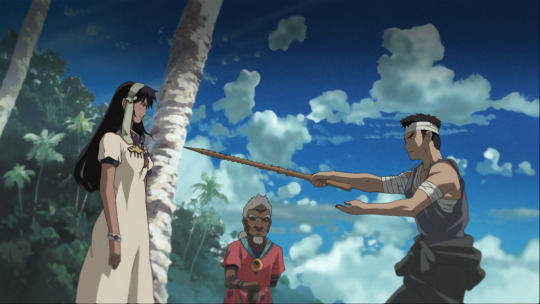
This is the first Macross chronologically, so it even though it has some alien tech that crash-landed to Earth, it predates actual alien contact and space war. Instead, all the major powers are wrapping up the Unification War, the “and then the Earth formed a world government to combat the imminent alien threat” narrative handwave of SDF Macross. We don't see much of the actual conflict on-screen, so instead it manifests as the settling of the frontier. The war is almost over and the fighting has been pushed to the fringes of the world, which means even nonaligned native islanders are at risk of being caught in the crossfire.
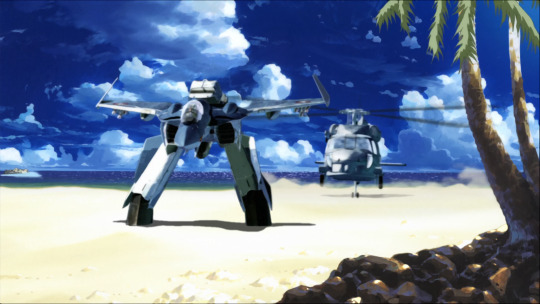
there's a real painterly nature to the backgrounds in this show, which helps the CG integrate quite well. Easily one of the best looking anime from the early 2000s.
Though the immediate problem is the military helicopters landing on the beach, it’s clear that the tribe has been facing the pressure of cultural imperialism for a long time now. Previous encounters have brought radios and generators to the island, and many members of the younger generations are leaving for mainland Asia to seek greater opportunities. This conflict manifests in the central love triangle as well. Sara Nome is a deeply religious traditionalist, while her younger sister Mao is the one interested in technology and anthropology. Macross Zero pulls no punches in depicting cultural isolationism as stifling and authoritarian. But the alternative is the end of their way of living, with only the potential for fragments of culture to persist through assimilation. And either way, the military being right at their door may soon render all this moot . The series grapples with hard problems in much better faith than most anime I've seen, which have a nasty tendency to advocate for colonialism.

Blood samples are one of Zero’s narrative through-lines, depicting the whole range of ethical hazards endemic to this kind of contact. The UN-sponsored cultural anthropologist who lands on the island takes indigenous blood samples under the half-truth that she’s going to test for diseases and treat the sick. Sara sees the writing on the wall, but can’t stop her from bribing the tribespeople with hard-to-get food and drinks. Of course, what the military scientists actually want to learn is how the islanders are linked to a suspected dormant protoculture superweapon, and to take advantage of it before the Anti-UN forces do the same.
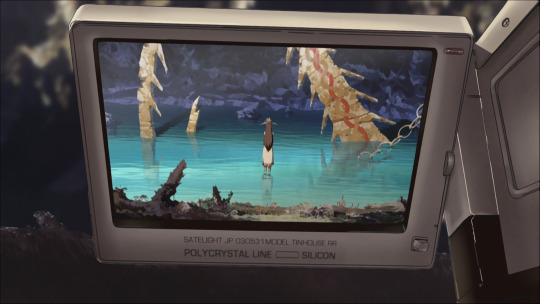
After discovering this, both the United Nations and the self-proclaimed anti-imperialist Anti-UN do not hesitate to use the island as a battlefield. While there’s plenty of sci-fi and magical macguffins during the last act, the show’s intentions remain firm. The can of worms opened when a UN fighter pilot first washed ashore reaches its inevitable conclusion, and everything burns and everyone has to be evacuated. Sara Nome reawakens the bird superweapon representative of her culture and ultimately uses it to open a portal, vanishing to parts unknown. That’s about the best this particular narrative can offer her viewpoint. Macross Frontier goes on to reveal that her sister Mao moved to the mainland and became a protoculture researcher, eventually becoming the grandmother of idol Sheryl Nome. It’s a fitting callback.

Zero is the most grounded and least optimistic Macross, and manages to avoid falling into pro-colonialist or noble savage viewpoints with its clear narrative focus. I would compare it to one of those UC Gundam side story OVAs, deliberately limited in scope but well-executed. One of the better ones.
Speaking of, Sunrise is going to be animating the next Macross anime! There’s a lot of possibilities, but first and foremost I hope they opt for a soft or hard reboot. Watching the most recent Delta movie left me to conclude that the internal chronology of the franchise has gotten far too messy, and it’s time to clean the slate so that culture shock can be brought to the forefront again. Of course, I’m also praying that they try to shamelessly cash in on G-Witch’s success by making The Gay Macross. God, what I would give for The Gay Macross. I could fill an entire second post with my ideas for The Gay Macross, but I’ll spare you for now.
15 notes
·
View notes
Note
Top 5 toy-driven anime for boys? For some reason I've been really noticing lately how much of the magical girl genre is essentially really pretty toy commercials and I'm kind of fascinated now by whatever the gendered flipside of that is.
Keroro Gunso

Keroro's a funny case because it wasn't always a toy driven franchise, it was just a boy's comedy manga heavy on anime references/parody and romcom hijinks, but once Sunrise & Bandai decided to be a sponsor for the anime adaptation you better believe it became one.
One aspect you have a team of color coded alien critters that are screaming to be made into marketable plushies. Each one even has a corresponding human character they're best friends kids can identify with. So there's that merch avenue
On the other hand you have Keroro's great love of Gundam model kits, a trait they leaned into hard. The show served not only to promote Keroro's toys but also real world Gundam models and other Bandai ventures. The funniest part of the 3rd movie to me is when they're all building a giant gundam model to fight against the bad guy and as a test of their friendship - and when they finish an orchestral cover of "Tobe! Gundam" plays in the background. Gundam models can solve all your problems kids!
2. Digimon

Where to even start with Digimon man...
It's strongest aspect as a toyline frachise was selling these guys with the ideal of having your own personal pet that can have conversations with you and all beat up your bullies, save you from danger, loves you unconditionally and help you grow into the best version of yourself. Digimon are the ultimate magical girl mascots if you ask me. While Pokemon has a big emphasis on collecting and working together as a big team - I like Digimon's spin on making it more personal.
3. SDF Macross

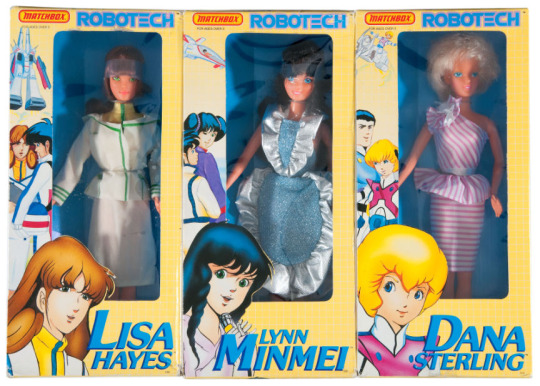
(I'm adding the "Women of Robotech" dolls because I think they're neat)
Macross may have more of a reputation for its music these days but in the 80's it was all about the giant robots & transforming planes! The VF-1S Valkyrie also went on to famously be added to Hasbro's Transformers toy line so when Harmony Gold wanted to make Robotech toys they couldn't sell it! 80's toy deals were a mess! Love it!
That all aside, the heart of Macross is it's drama and it's analysis of humanity adapting to weird af conditions. What do we fight for, how do we solve conflicts, how do we create, how to we continue to grow - the answer is to sing pop music until the aliens leave us alone. In my mind the planes & robots are just a fun bonus to everything else lol.
4. Yu-Gi-Oh
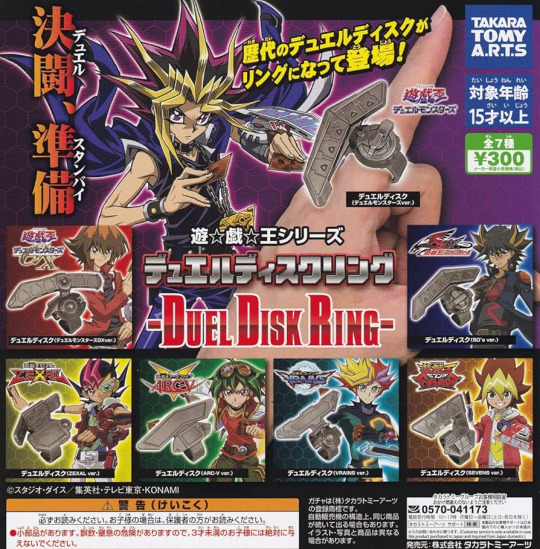
I had a huge Yugioh phase in early High School so I gotta mention it even if I wasn't really into it for the toys. I liked the monsters and the characters/story and tried to get into the card game but it didn't stick. I didn't have a hard time learning the rules though.
5. Saint Seiya

I'll be real, I've never been really into Saint Seiya's story or characters much, but I LOVE its aesthetics. If I was a kid in the 80s I probably would've gone nuts for this. A bunch of cool fighters named after stars and you can go and collect them all and collect all their cool outfits? I keep trying to get into it each iteration (the closest was probably Saintia Shou or Saint Seiya Omega) and it never sticks, but dang it looks cool
11 notes
·
View notes
Text
my queer ass started rewatching sdf macross for the first time since i was like...14-ish years old
god it's been 13 years and this time i'm not watching it on some shady watch anime free online website like i did back then lol.
instead i'm doing what i do with most anime i watch these days: i pirated that shit. downloaded it a few days ago, 65 GB, 1080p BD rip with subs (and extras taken from the BD). good shit, good shit.
god old animation looks great in HD
3 notes
·
View notes
Text
Diving into the Digital Trip

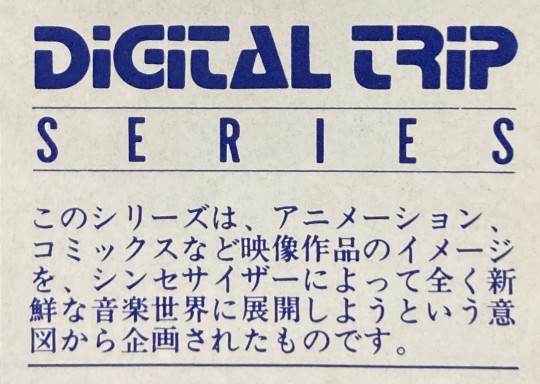
“This series was conceived with the intention of taking impressions from animation, comics, and other visual works and developing them into a completely fresh musical world using synthesizers.”
-Obi Strip Digital Trip Series Description, 1983 (SDF Macross DT, translated by Windii)
Intro
When I first started listening through tokusatsu soundtracks, I was going through the two-disc set for Uchuu Keiji Sharivan’s BGM and noticed that the second disc began with a set of songs titled “DIGITAL TRIP Uchuu Keiji Sharivan SYNTHESIZER FANTASY.” Upon playing those curious tracks, I was greeted with a very electronic, synthesized, and striking series of compositions. They were still recognizable as variations of the OST and BGM I’d heard earlier, yet they sounded almost otherworldly.
Years of anisong searching and listening later, and now as an avid music enthusiast, I’ve plunged into the huge range of the Digital Trip – Synthesizer Fantasy albums. Though only lasting around five years, the series saw many releases from a variety of arrangers offering their own, synthesizer-heavy takes on anime and other Japanese media music.
Some of the albums recently received worldwide streaming releases for the first time, but I wanted to write about this series anyways because of how much I enjoyed listening through and discovering so many favorites. I love synthesizer music of all kinds, especially ones that aim for their own distinctive style. The Digital Trip series is unique among both electronic and anime music, and I think it’s worth highlighting as a creative and entertaining series of albums.
This retrospective is a mix of contextual overview, notes on the styles of the main arrangers, a look at some of the tech used, the end of the line itself, and ten personal album recommendations.
(VGMDB is the source for most of the credits and dates in this post.)
Overview
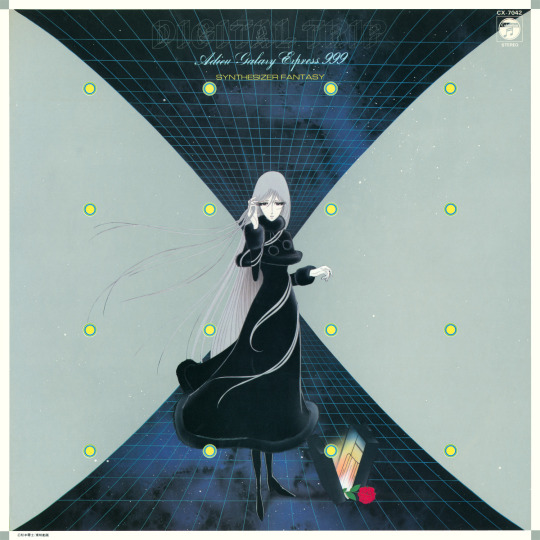
Digital Trip – Synthesizer Fantasy is a series of instrumental image albums released by the Nippon Columbia record label in Japan from December 1981 to May 1986. 51 albums (and one compilation) were produced for it, with each receiving a simultaneous vinyl and cassette release. At its peak, multiple albums were released almost every month, though the typical schedule had more gaps.
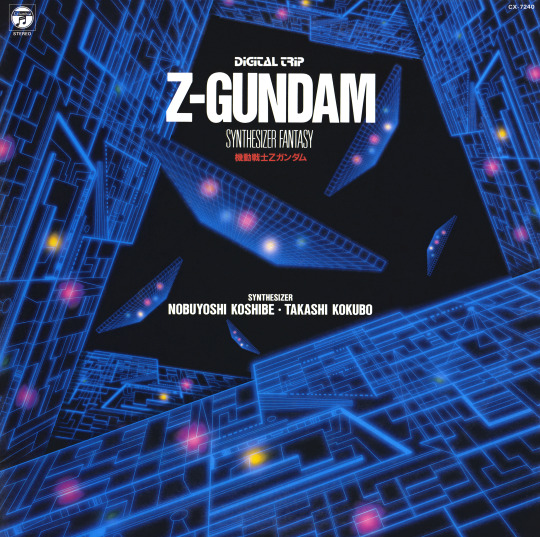
Befitting the name, the albums are synthesizer-focused re-arrangements of vocal, BGM, and image songs for select anime, manga, and even tokusatsu. A few albums have original compositions, but the majority are reinterpretations of existing songs and scores. The albums feature some of the newest emerging synthesizers, samplers, sequencers, and drum machines of their release years, though a rare few have more traditional instruments mixed in. Despite the “digital” name, older analog synthesizers are used on some albums alongside newer digital synths.
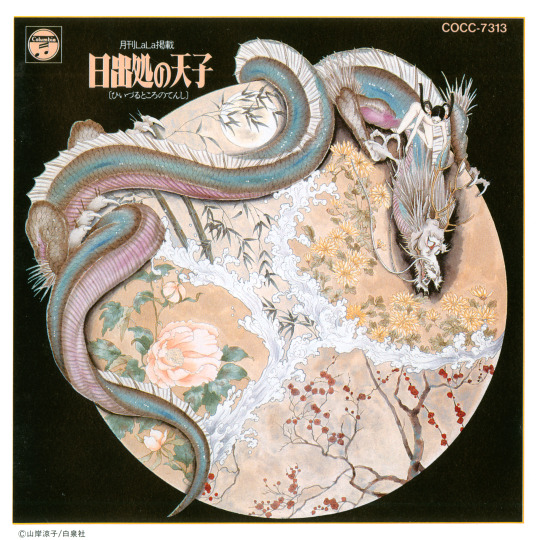
Nippon Columbia had other similar image album lines that started running concurrently in 1983. The Jam Trip series is the same concept as the DT albums but with jazz-fusion rearrangements instead of synthy ones, and the Roman Trip series is image songs for manga and books that had not received animated adaptations yet. Some of the early DT albums are original image albums for manga, but they soon switched to covering anime while the Roman Trip line focused on new image songs for non-animated works.
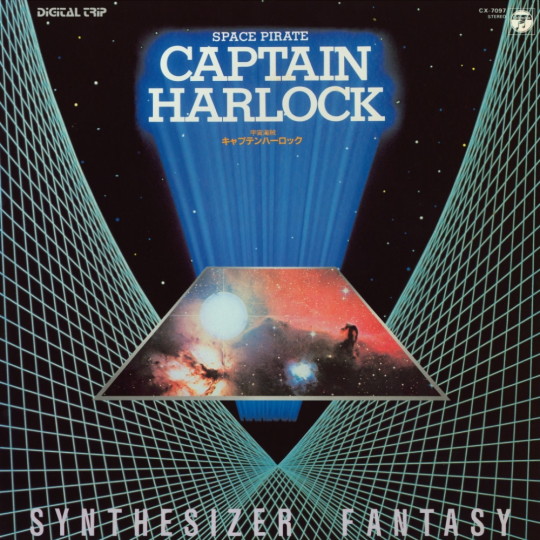
Image albums were common music releases throughout the late 70s and 80s onwards, but the DT series is focused on a more specific, overarching concept of making distinctly electronic renditions. The potential of synthesizers and newer computer technologies was captivating for musicians and audiences across the world at the time, so the DT series served as a chance to both experiment with these new tools and to showcase the kind of layered and unique compositions synthesizers were capable of.

This concept is also reflected in the album art, which tends to feature more abstract designs and lots of futuristic grid lines and shapes that aren’t always obvious reflections of their source anime. Most of the anime selected were science fiction and fantasy given the nature of the concept, but several non-fantasy anime also received albums.
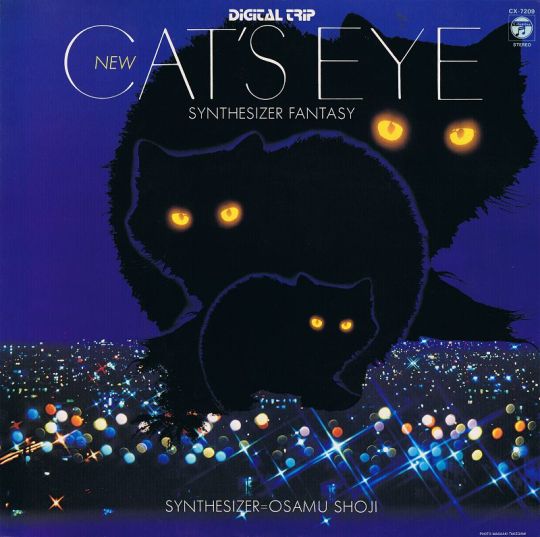
The tracks on DT albums are mostly based on the existing works of composers, but the actual arrangements and performance are handled by different arrangers, with a few exceptions. While the original compositions still influenced how each album ended up, the arrangers played the largest role in shaping them through their own skills and visions. The music in each album ranges from more conventional rearrangements, airy ballads, electro-dance, faster rock, atmospheric soundscapes, longer suites, and a whole host of other styles.
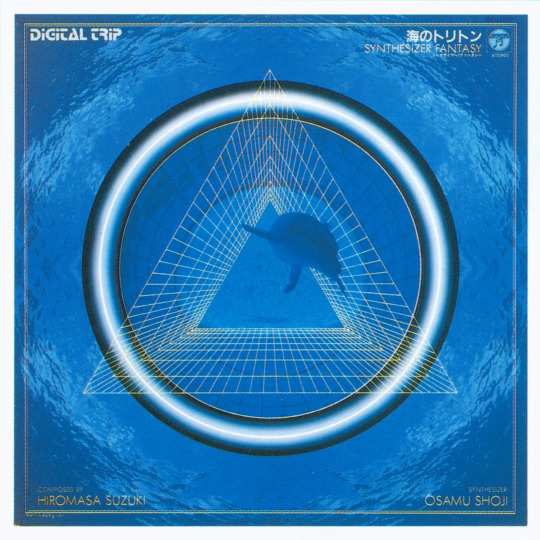
I don’t think any of the DT albums are bad, but the less unique ones fall into the trap of keeping the compositions too similar to the originals. The least interesting tracks sound just like the original songs with the instruments swapped, but those are thankfully rare. While the DT albums can be listened to without any knowledge of their base soundtracks, comparing them with their original scores highlights how creative and varied the rearrangements can be when working with a totally different sonic palette.
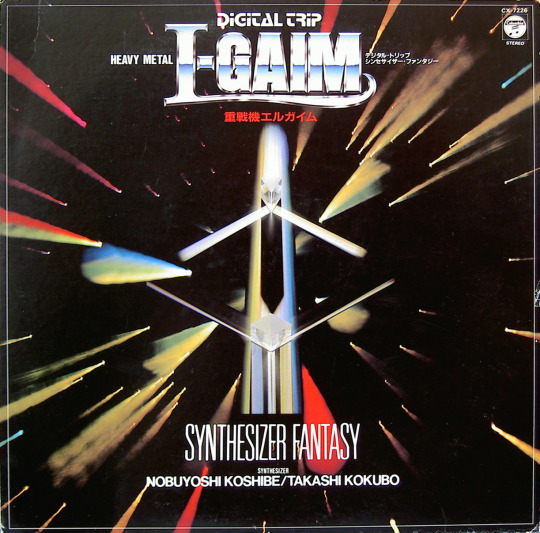
At their best, the DT albums strike a balance of being faithful enough that the original compositions are still recognizable while also transforming them such that they stand on their own. Sometimes multiple songs are mixed into larger suites, and other times each vocal song and chosen BGM gets its own track, but each track contains new flourishes and notes that add to the original compositions, as well as going into unpredictable directions and styles. The rearrangements of vocal songs are some of the livelier ones, but part of the enjoyment is seeing all kinds of songs reinterpreted though this “Synthesizer Fantasy” concept.
The Main Arrangers
While there were several one-off arrangers, the Digital Trip series had a rotation of regulars that carried their own styles across multiple albums. A few of the more prominent ones included:
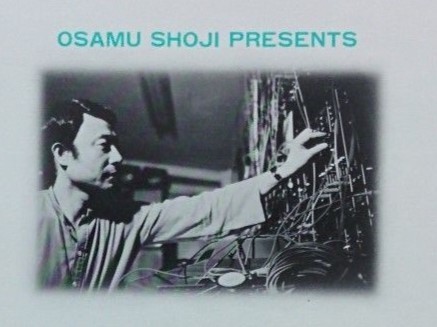
Osamu Shoji (“The Galaxy”): 20 albums
Osamu Shoji was the primary arranger of the DT series and handled a plurality of the albums. As the first and last arranger of the series, his progression throughout the run is interesting to track as he adopted many newer synthesizers and changed his sound the most.
Shoji’s arrangements are mostly straightforward, but that helps them maintain a solid base structure no matter how different the styles are from one track to the next. It reflects his adaptability that he was able to integrate so many different composers and genres into his DT albums that are distinct from both each other and their original soundtracks. Lots of his tracks tend to be more sequenced, but they use that to their advantage to create complex rhythms, tight grooves, and sturdy percussion backing the more active main melodies. His music’s audio mixes sound deep and well-rounded despite their many different sound tones. Shoji remained the most versatile and reliable arranger in the lineup, shaping the bulk of the DT series.
Shoji released many solo electronic albums and other assorted anime image albums, including the two “Synthesizer Fantasy” image albums that were not in DT series. He composed for a few anime including Adieu Galaxy Express 999, Cobra, and Wicked City.

Nobuyoshi Koshibe & Takashi Kokubo: 11 albums + 1 Koshibe solo
The second-most frequent arrangers, Nobuyoshi Koshibe and Takashi Kokubo used some of the wider varieties of synthesizers in the DT series. Their albums have a very crisp and buzzy sound, and their tracks often undergo several instrumental and style changeups throughout. They also feature some of the hardest rocking tracks in the DT series, especially with their louder use of sharper and heavy FM synth tones, but also with very processed, effects-heavy guitars for accents and solos. That said, their albums still have considerable range beyond their rock tracks, with many slower and more atmospheric songs that are gentler when needed.
Koshibe was already an extensive anime vocal song and soundtrack composer prior to the DT series for shows in the 60s and 70s, including giants like Saze-san and Mach GoGoGo/Speed Racer, and he continued working in anisong music afterwards. Kokubo only contributed to one other anime album outside of his DT work, and he was more focused on his solo electronic and new age albums.
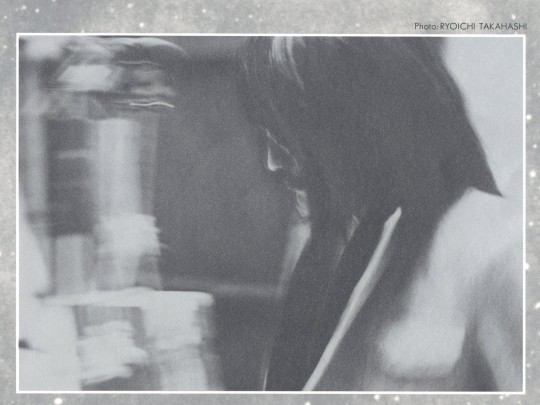
Jun Fukamachi: 4 albums
Though his albums were few, Jun Fukamachi had one of the most distinct and beautiful sound palettes in the entire DT series. Compared to the others, Fukimachi’s albums emphasize a much more “live,” almost classical performance with lots of gentle and expressive keyboard flourishes. His arrangements are mostly scarce on percussion and instead aimed for a more symphonic sound with layers of pads and arpeggios backing his sweeping synth leads and solos. While he has more upbeat and harsher songs, most of his works are ethereal and lush. Fittingly, three of his four albums are based on works by Leiji Matsumoto, and his arrangements excel at capturing the grand atmosphere of space opera.
Fukamachi made a couple of other image albums and never composed any anime scores, but he did have an extensive jazz-fusion and electronic career spanning dozens of albums.
Goro Ohmi: 4 albums
Goro Ohmi was more involved in the early run of the DT line. His first few albums have some accompaniment from live instruments while his later ones were more synth-centered. His works are some of the more accessible ones in that they tend towards more straightforward covers that stick closer to the original compositions. Still, they’re solid reinterpretations with enough creative additions. His synths are a touch more primitive than the others, but he still managed to make his arrangements sound full and varied.
Ohmi pivoted to handling many of the Roman Trip albums for Guin Saga, which he continued into the 90s. He composed a few anime and tokusatsu soundtracks afterwards, including Ginga Nagareboshi Gin, Grey: Digital Target, and Hikari Sentai Maskman.
Akira Ito: 2 albums
Akira Ito only composed two image albums of original music near the start of the series before he left the rotation early on. His works are some of the less “digital” in that they contain lots of traditional rock instrumentation, with the synths usually playing only the leads. His style is most akin to 70s progressive rock, with lengthier songs that all flow into each other to form large suites. His two albums have a very fantastical, journeying sound that’s not too representative of the DT line overall but remain interesting outliers.
Ito has a few anime image albums credited to him, but he was more focused on his solo electronic albums that continued this same style.
Appo Sound Project: 2 albums
Appo were a production group of composers and arrangers that arrived near the end of the series, but they still carved out a distinctive treble-focused, more high-NRG sound relative to the others. Their arrangements use sharper digital synthesizers that are very bright in their sound mixes, if occasionally on the thinner side. A lot of their arrangements were more up-tempo and not as subtle, but they have a constant energy that’s still enjoyable, especially in their tracks with multi-suite melodies.
Also of note is that the group features Kohei Tanaka in one of his earlier arranging roles. In fact, a lot of the synth sounds of their work are used in the electronic tracks he composed for his Choushinsei Flashman soundtrack soon after. Tanaka remains one of the most well-known anime composers of all time and went on to compose many, many soundtracks afterwards, though none really sound like his DT work.
Tech

(From the Adieu Galaxy Express 999 DT Album)
Given their concept, the Digital Trip albums are tied to the synthesizer technology of the early 80s, with all their quirks and limitations. The albums are rather accessible for early electronic music, but their sounds are challenging for those not as predisposed to synthesizers. Nevertheless, exploring aspects of the synth technology at the time illustrates the ingenuity needed to make the albums.
Early synthesizers and sequencers were trickier to operate and program compared to later advancements. All settings for sounds had to be individually connected with cables, tuned with knobs, or programmed with basic keypads. On the few units that had them, display screens were minuscule and had few lines. Storage banks were also limited, so saving any sounds to reuse for later often required meticulous notetaking.
Keys on older synthesizers were also not as touch-sensitive, meaning the notes would sound the same regardless of how fast or hard the keys were pressed. Pitch and modulation control were often present but rather basic. Polyphony, or the ability to play more than one key at once, varied widely by keyboards, which also made full chords harder to play.
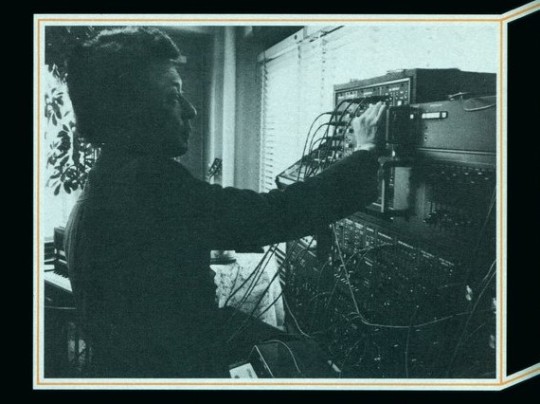
(Osamu Shoji, from the Adieu Galaxy Express 999 DT Album)
Many of the albums were made before the MIDI standard was codified in 1983. Pre-MIDI sequencers had limited interfaces that required all aspects of each note to be programmed individually, though this did allow for finer precision. Timing sequences with live playing was also a challenge for units that had variable sound consistency and different communication formats.
This made configuring each part of a single song with only synthesizers a laborious process, especially for albums that were 30 to 40 minutes long. The arrangers not only had to rearrange the original notes to work within the technical capabilities of each synthesizer they wanted to use, but they then had to make sure each synth was attuned and set up correctly for recording and mixing. Some DT albums have additional engineers credited who assisted with the tedious work of configuring these different systems and note sequences, but the arrangers were still responsible for the bulk of the work in planning and connecting all of these machines.
The liner notes for some albums include lists of the synthesizers and instruments used, which also reflect the habits of their respective arrangers. While going over the instruments for every album would be lengthy, comparing two albums that were both released in 1983 yet contained wildly different sounds illustrates these varying sonic approaches.

(Osamu Shoji using the Fairlight CMI, from the God Mars DT)
The Macross DT album by Osamu Shoji only lists the Fairlight CMI sampler, the Linn Drum II (the “classic” LinnDrum), and the Roland MC-4 sequencer. This means every non LinnDrum sound on the album is produced just from the CMI’s digital sample library, albeit with his own modifications and even his own sampled noises.
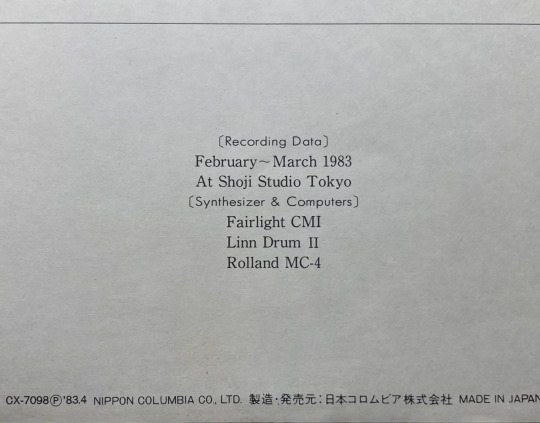
The album’s diverse styles and instruments, from the upbeat pop and action to the grander slow songs, reflect both the CMI’s depth and Shoji’s skill as an arranger and programmer. Shoji’s equipment range is broader on works like his Adieu Galaxy Express 999 and Gundam DTs, but the Macross DT demonstrates how it was still possible to make a wide-ranging album with such a small selection of tools that had expansive capabilities in the right hands.
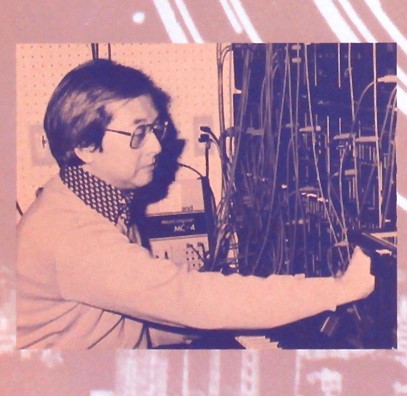
(Koshibe using the Roland System 700 and MC-4)
By contrast, the Urashiman DT by Koshibe & Kokubo has a longer and more peculiar list of instruments, and it also includes the recording and mixing equipment. The first synth listed is the analog Roland System 700 from 1976, an older modular synthesizer that required connecting streams of wires between each individual sub-unit and lots of manual tuning to get the desired sounds. A picture in the liner notes shows Koshibe working with both the System 700 and the MC-4 sequencer. The rest of the list contains a mix of synthesizers, both analog (Roland JP-4, SVC-350 vocoder) and digital (Yamaha CE-25, DX-7, Korg PS-3200), with vastly different sound tones, many of which show up across the duo’s other albums. The amount of moving parts to sequence, tune, and play is daunting, but the album’s layered sound reflects this approach well.
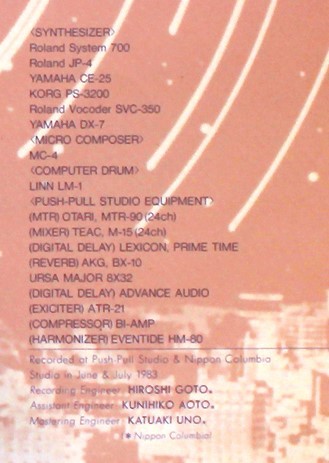
Not all the albums list the synthesizers used. Most of Fukumachi’s albums only have a generic “synthesizers” credit, which is frustrating considering how distinct his style is. Some albums have liner notes describing the process and approach taken for every track. The Macross DT liner notes go into the techniques Shoji used with the CMI and sequencers to make the album. I hope to get more of those translated in the future, but the depth of the arranging process is still reflected by the structure of the tracks.
While the technical craft in employing all of these tools is remarkable, there are limitations. Some albums unapologetically use presets that became cliched as the decade went on; the DX7’s tubular bells, the Fairlight CMI’s panflute samples, and the LinnDrum’s tom-toms show up quite a few times. The depth of the sounds and tones varies across the albums and arrangers, and many presets were at lower bit resolutions and sample rates than what future samplers were capable of. However, the use of digital instruments and sometimes recording does give most of the albums a better mix clarity than many of their associated soundtracks.
Knowing about the technical aspects is not needed to enjoy the albums on their own, but it does give deeper insight into how certain sounds and stylistic choices were possible. While it is easy to lump all early synth music of this kind as being generically “80’s,” the actual process was much more varied and evolving. The changing styles in the DT line reflect the technological advancement and programming refinement spreading throughout music at the time, which the arrangers furthered through their continuous work.
Other Uses
While some Digital Trip albums came out long after their respective anime and movies, most were released a short time after the first batches of official soundtracks. This meant they tend to cover music from the earlier episodes of 40-50 episode shows, though a few got sequel albums that covered later music.
Because the DT albums are image albums, their music was not intended for use within their respective anime, especially for shows with more traditional and orchestral soundtracks. I haven’t seen all the anime, shows, and movies with the associated albums, but I have seen enough to know it is exceedingly rare for any DT tracks to appear.

However, there are a few exceptions. Urashiman uses a few tracks from its DT album in some episodes across its endgame arc. The most memorable scene is in episode 45 where a stylish non-binary assassin demonstrates their skills to the villains, set to the DT version of the villains’ vocal insert song. It’s a great choice that makes the scene even punchier. Episodes 46-49 also use other more sweeping tracks from the album to accentuate more dramatic scenes.
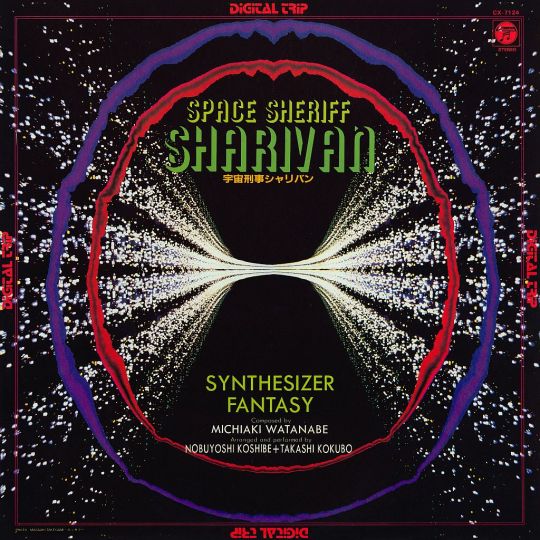
Sharivan also starts using DT tracks in episode 35, which uses a lengthy portion of the final song on the album for a heartfelt montage. More of the DT songs are used as insert songs in episodes throughout the rest of the series, making it likely the most extensively used DT album for its respective show. Sharivan does have lots of one-off synthy songs that aren’t the DT songs or on its official soundtrack, but the DT ones are still discernable with a keen ear.
In both cases, the respective shows’ soundtracks already had numerous synthesizer songs, so the DT albums fit more naturally in with the rest of the music. Coincidentally, both shows had their original soundtracks released by Nippon Columbia, but that’s a sample too small to make definitive claims about. Though rare, hearing DT tracks used in the shows is always a nice touch.
(If I ever find other examples of DT tracks used as insert songs, or other people are aware of some, I’ll update this section.)
The End of the Series and the Changing Landscape
The last album released in the Digital Trip series was the Arion album in May 1986. I can’t find a source on why the series ended, and it’s not helpful to throw out baseless speculations on why. That said, the changing landscape around the DT albums is still interesting and reflective of the series’ legacy.
As the 80s rolled along, synths became more conventional parts of anime scores rather than getting used primarily as accents, a change facilitated as the technology advanced and got easier to use. Some of the original novelty of hearing electronic-centered albums was dissipating as some anime scores themselves became very electronic. Nevertheless, the DT series was still dedicated to making unique arrangements on their own that differed from the synth work in their respective anime.
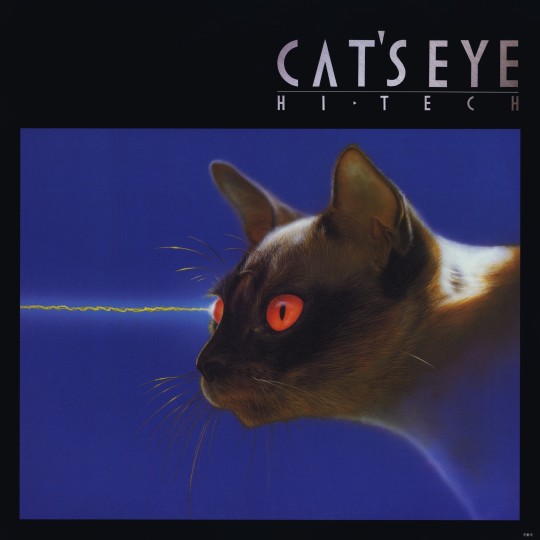
However, other sublines of electronic rearrangement albums began emerging at the same time. The Animage label launched their own line of synth-focused image albums called the HI▾TECH series in 1984, although those albums often included more regular instruments than most of the DT entries. Because both the DT and HT lines were covers and rearrangements, some anime received albums in both lines. The HT series ended its regular releases in 1986, but it released a few other albums over the following years.
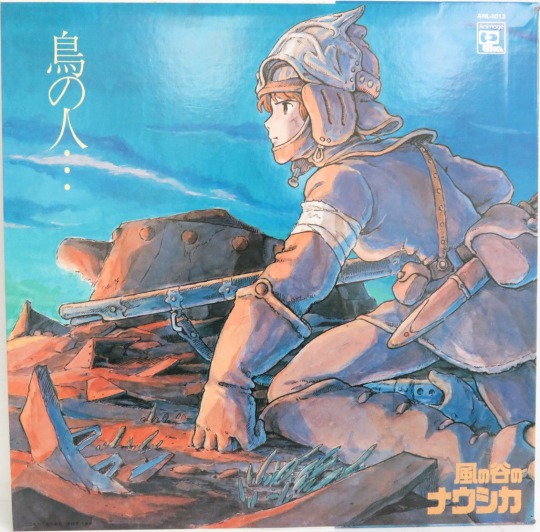
Additionally, other electronic-centered image albums were increasingly helmed by the composers of their anime’s soundtracks. As Joe Hisashi’s career began taking off, he started creating synth-focused image albums that were often released before their respective movie scores, in some cases functioning as “prototype” scores as he was still working on the main soundtrack, including ones for Nausicaa and Arion. He continued the practice through the end of the decade with albums like his Venus Wars image album.
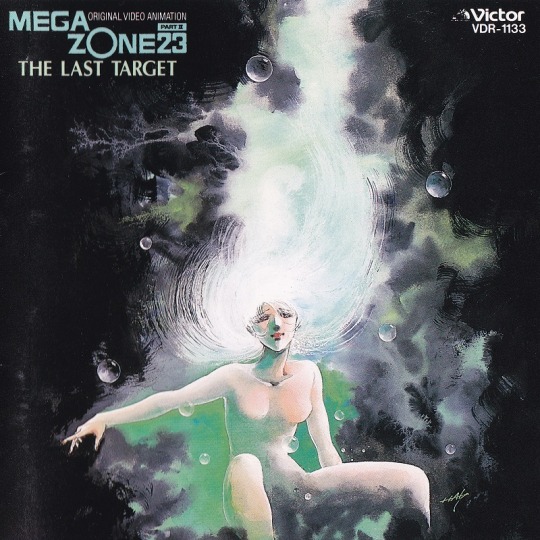
Shiro Sagisu, another then-upcoming composer, took a similar route with his music for Megazone 23 under his TOKIO 23 unit. Megazone 23’s score was already very electronic, but he released two additional synth-heavy image albums in between the releases of the scores for Part I and II that were not only rearrangements, but also contained unique compositions. More composers were feeling confident and adept with synthesizer and electronic music to begin releasing their own image albums in addition to covers from outside arrangers.
The case of the Arion soundtracks illustrates this expanding field. Through the span of year from 1985-6, Arion had its partially synthy movie soundtrack, a Digital Trip album, a Hi-Tech album, and a separate synth “prototype” image album by Hisashi himself, not to mention an even earlier 1983 synthy image album based on the manga that predates the movie score. That’s a huge saturation of Arion synth albums, reflecting how more releases were competing for the same niche the DT series had occupied.
Now, I’ve had enough experience with nonsense internet anime rumors to say that none of this is verifiably connected to the reasons the DT series ended, and it should not be treated as such.
Nevertheless, these circumstances highlight how aspects of the DT series became featured in contemporaneous soundtrack and image albums, which to an extent succeeded the DT line after it ended. More producers, artists, and most importantly, consumers were now acquainted with and enthusiastic about synthesizer music than ever before. Synthesizers were now a core, if not predominant aspect of many anime and popular music albums compared to their marginal use earlier in the decade when the DT series began.
The Digital Trip Albums Now
After the initial run in the 80s, 14 of the albums were remastered onto CD in 1993 under Columbia’s Digital Trip 1800 series. The original LP art was shrunk within a wider blue border, but the booklets mostly contained the same liner notes. 10 of those CDs were reprinted again on CD-R’s under the R-Ban series in 2001.

A few were also remastered onto CD on other compilation releases: the Sharivan DT on the two-disc Sharivan OST and other compilations, both the Yamato and Final Yamato DTs on the Yamato Sound Almanac series, and the Harlock DT in the Harlock Eternal File series, to name a few.
In 2012, Columbia put out a digital-only compilation release that included a few tracks from DT albums that had no CD remasters. Curiously, the release has no tracks from Osamu Shoji and has a large chunk of its tracklist taken up by songs from the Ultraman DT album, except for its final one.
Unfortunately, the majority of the DT albums remain exclusively on their original vinyl and cassette releases and have not seen any official CD or digital transfers, and it is uncertain if they ever will unless Nippon Columbia decides to do so. The 2012 compilation is evidence that Columbia still has the materials available to make remasters for at least a few more albums, but there’s been no sign they’re considering any more.
Somewhat recently, the DT albums in the R-Ban series and two other CD-released ones were officially uploaded to streaming on Spotify, Apple Music, and Youtube Music. (6/5/24: The Sharivan DT was also released as a part of the uploads for the Metal Heroes Super Hero Chronicles, at the end of the fourth album). Curiously, the artwork on these releases is edited to remove all mentions of the phrase “Digital Trip”, both on the title borders and the original album cover. This does result in a few comically empty spaces, like on the Arion cover, but it’s an odd choice since they’re still titled “Digital Trip” in the album names.

As usual for anime fans, the best option to find most of these are through the varying places online. A fair number of them get uploaded to Youtube for the more casual listeners, but the majority are not too hard to find through other sources including conventions, digital stores, and fan rips floating around online.
Conclusion

There’s more to the Digital Trip – Synthesizer Fantasy line and its many albums, but this is about everything I wanted to touch on for now. The albums remain decently well known among retro anime music enthusiasts, but that’s about three layers of niches, so I think I can say that they are still relatively obscure to wider anime fans. The electronic nature of the series is its defining attribute, and that may take some time to get invested in. Still, this is a topic I wanted to cover mainly as a passionate fan but also to provide a decently comprehensive overview of a noteworthy anime image album series.
Synth-focused image albums appeared before and continued well after the Digital Trip series, but it stands as a noteworthy confluence of trends whose arrangers produced many unique, varied, and most of all, engaging albums. A DT album is appreciable irrespective of the original soundtrack it is arranging. Some of my favorite DT albums are for anime I haven’t seen or whose scores I haven’t heard because they were still that evocative on their own. Still, comparing the two highlight interesting aspects of the rearrangements needed to bring the music to synthesized soundscapes.
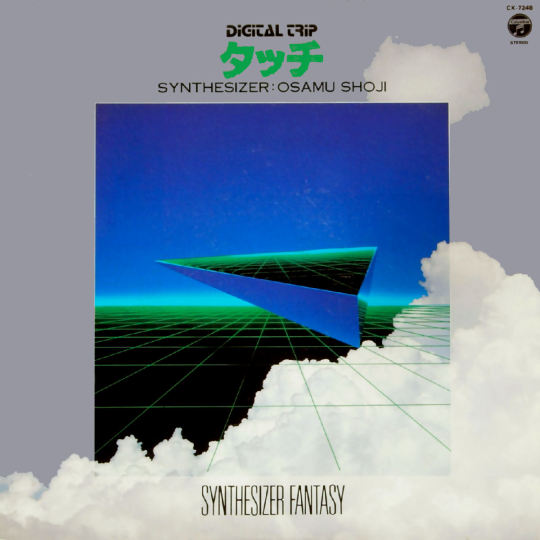
In the future, I hope to have more of the liner notes from the albums translated to shed even better details on the arranging process. Some of this overview involved generalizing, but I always want to get down to more precise details whenever possible. I may return to covering other aspects of the albums in the future, and I also plan to check out more of the non-DT works from all the respective arrangers.
After this section, I have ten personally recommended Digital Trip albums, in no particular order, as well as additional notes for a few external links, including a playlist of all the officially streaming ones on Youtube.
I encourage anyone interested in anime music, earlier electronic music, or those curious in general to check these albums out. The Digital Trip series is one of my favorite anime image album lines, and I think they carved out a distinct identity that remains interesting even so many years later.
10 Personal Favorites
SDF Macross (Osamu Shoji) – A solid selection of the show’s most famous vocal songs and BGM tracks (although curiously lacking “Watashi no Pilot”) that mixes idol-pop catchiness, fast-paced action, and grander spacey tracks. The bending and expressive keyboard basslines are a huge highlight. The Macross II: Minmay’s Songs album by Koshibe & Kokubo is also an interesting contrast in tech and style. (Translated liner notes for the album are here.)
Uchuu Keiji Sharivan (Koshibe & Kokubo) – My favorite of the Koshibe & Kokubo albums and the first I listened to, this one has lots of very sharp and buzzy FM synth tones. The rare splashes of electric guitars have tons of processing that make them sound roaring. Since Sharivan had a larger album of vocal songs to draw from than most of the other shows, the arrangements here are very lively and go through some fun changeups.
Umi no Triton (Osamu Shoji) – Though much later to its anime compared to the others, this album shines the most in its very catchy beats and rhythmic pulses. While not as atmospheric and sweeping, it still captures an oceanic feel with its twinkling arpeggios and chunky bass. It’s an unexpected combination of styles that works surprisingly well.
Gekkan La La Rensai Hiizuru Tokoro no Tenshi (Akira Ito) – This one is technically closer to the Roman Trip albums since it contains original compositions based off a historical fantasy manga and uses more traditional instruments in several parts. Still, it has a wide range of tracks that all connect into a continuous suite, making it one of the more cohesive and adventurous albums of the DT series, with lots of Japanese-styled instrumentation.
Mechadoc (Koshibe and Kokubo) – An underrated album that reflects the automotive feeling of its anime. Its highest energy tracks capture the grittiness and speed of racing and rally cars, especially some of the sharp FM lead solos, while the more mellow tracks round them out with gentle tones. The songs are lengthy but shift and develop in engaging ways.
Lensman (Osamu Shoji) – As well as having a more futuristic vibe overall, this album really excels with its rapid, complex drum and percussion patterns. Most of the album is a solid combination of upbeat action and funkier tracks, but towards the end there’s slower atmospheric cuts that balance things out.
Cat’s Eye (Osamu Shoji) – A more city-pop effort that’s very playful and even cutesy at times, most so with its danceable beats and bouncy basslines. The longer track list also allows for more songs that are focused and succinct. Shoji’s New Cat’s Eye album for the show’s second-season music continues a similar style.
Nausicaa (Junko Miyagi) – From the one-off (and only female) arranger Junko Miyagi, this one is among the most fantastical and soaring of the DT albums, especially with its thick bass pads and whistling tones. It’s also different from the many image albums Joe Hisashi made for Nausicaa, so it’s a good entry point for those already familiar with his music and curious about the DT albums’ overall concept.
Queen Emeraldas/Emeraldus (Jun Fukamachi) – My favorite of Fukamachi’s works, it features some of the lushest arrangements of the entire DT series, including several original compositions. The many glistening arpeggios and gentle keyboards perfectly evoke the feeling of travelling the immense galaxy with tracks that sound both forlorn and blissful. It also comes the closest to feeling like a “live” performance with its subtle, expressive keys.
Arion (Osamu Shoji) – The last DT album released, Shoji showcases his widest range in a lengthy tracklist covering almost every major cue from the movie score. The rapid and rhythmic drums accentuate many tracks nicely, the synth tones have greater depth and layers, and the varied arrangements capture the score’s fantasy atmosphere. It’s a well-rounded and solid album that’s also a fitting sendoff for the series.
Other Links and Miscellany
A playlist of all the officially streaming Digital Trip albums on Youtube, organized chronologically by release date. Lots of the others are available through fan uploads.
VGMDB is an invaluable database for these albums, even if many entries still need more complete details and could always use more contributors and enthusiasts. Note that viewing the full album art and insert scans requires an account.
The aforementioned 2012 Columbia digital release, which has some previews of some other DT tracks.
For a better introduction to synthesizer tech, I can recommend this two-part article from Yamaha on the history of synthesizers and an article from MIDI on the history of sequencing.
This video demonstration of the Roland MC-4 sequencer by Alex Ball is an excellent showcase of its programing process, as well as how arduous it was to make a full sequence. His channel in general is great if you’re into older synthesizers!
For a while only the R-Ban ones were on streaming, but two other CD ones were added to streaming as I was writing this post. Here’s hoping for more!
One oddity MartyMcFlies helpfully pointed out to me; there is a synthesizer album for the Odin: Photon Sailer Starlight film that’s titled “TPO Synthesizer” that has both original music used in the film and synth image covers of the film’s other BGM. “Digital Trip” is printed on the LP label itself, but without the “Synthesizer Fantasy” tagline (instead it’s “Digital Trip Original Soundtrack”). The DT tagline is not mentioned anywhere else in the album, and it does not seem to be included in any listings of the line. He has no idea what the situation behind this weird printing is, but he asked me to mention it regardless. Thanks Marty!
6/5/24:
As a part of the Super Hero Chronicles Albums for the Metal Heroes shows, the Sharivan Digital Trip is also now on streaming at the tail end of the fourth album.
3 notes
·
View notes
Text

Macross 7
マクロス7
(Anime + ova + film)
Mecha romance musical by Shoji Kawamori
Era: 1990s
Rating: S
Plot: Around 30 years after the developments of SDF Macross, humanity and their new allies, the Zentradi, are expanding their reach to outer space in the Macross 7. There, they meet the a new enemy - aliens who seem to feast on the life force of their victims, first on the pilots defending the spaceship convoy, and then on the city onboard the 7 itself. As this happens, Basara Nekki, vocalist of rock band Fire Bomber, with Ray Lovelock and Veffidas Feaze and new bass player and female vocalist Mylene Flare Jenius, daughter of Max and Milia. He also mysteriously has a custom VF-19.
Length: 49 episodes, 2 OVA and a 2 films
Thoughts: Ah, if Plus was a bit "what if we made Macross but made it unlike Macross", this is probably the quintessential Macross experience. Does it have variable fighters? Yes. Is there an aspiring music star in a love triangle? Yes... kinda. Is their music connected to protoculture? Buddy, not only that, it becomes the main weapon. Does it have tension between the civilian side and military side (who can't be trusted) of the Macross? You're not going to believe it, but there's even two aspects to it. So let's start by that. Because they likely learned a few lessons over having the civilian and military together, the 7 has a combat module similar to the original Macross that can detach itself from the civilian module which can turtle itself during combat, and in charge of both are respectively Max and Milia, now estranged after maybe too many tossed babies. Our boy Basara is a pacifist firm in his conviction his songs, not fighting, can move a mountain and change the universe. He butts in anytime there's a fight between the forces defending the 7 and the attackers by dodging every attack and firing speaker pods at their enemies, to the annoyance of Gamlin, the ace pilot on board. What he (and even Basara himself) doesn't know is that it all is part of a secret program Ray and Max cooked up, trying to develop an attack that mimics Minmei's years prior, this being the main driver of the first half of the story. While at first he seems more an annoyance, we get the first hints of success and why they're being attacked by the "vampires", who need Spiritia (or life force or whatever you want to call it) and their leader dreams of regenerating Spiritia, allowing them to stop hunting other species, and while attacking a musician, they see the effect Mylene and Basara singing has on the recovery of her levels, and later kickstart the recovery of a captured pilot, and even make Sivil, one of the Protodevlin behind the attack... uuh... feel things and make faces that were probably not seen before outside something you could only buy from a mail-order catalog that only advertised on magazines sold behind the counter, and later the full weaponisation of Fire Bomber as Sound Force, setting the stage for the later half of the season, focused on the fight between the Macross 7 and the Protodevlin. The love triangle is never exactly resolved, which is a good thing because, you know, jail, but it's questionable if there really was one to begin with as Basara is interested in one thing only, and it is to make people listen to his song.
This idea that music can change the universe is baked into the franchise, and the way it is taken literally here is Macross taken to the most Macross it can be, and putting it in writing makes me understand it can be very ridiculous and why some might not like it. The characters are also very fun, but quite one note throughout the story, beyond Gamlin taking the broom out if his ass, and it feels some of them, like Rex and her gang or the bridge bunnies could have had a bit more time for them. Visually it's very much a solid mid 90s show, although it's not the pure spectacle of Plus and recycles *a lot* of animation, the music sequences are on a level probably not seen outside magical girl transformations.
So, 49 episodes are enough to tell the whole point of the show: finally allowing the long-suffering Flower Girl to give Basara a bouquet, but given its success there's more to it - first was The Galaxy Is Calling Me, a 30 minute movie taking place in the later third of the show, where Basara crashes into a struggling mining planet due to a Fold disturbance while chasing a powerful voice picked up by their monitoring systems who turns out to be a familiar face to some of the characters (B), same with the Encore OVA, with three stories taking place around midway where we get to see a TV documentary on the lives of Ray and Basara before forming Fire Bomber, very inaccurate re-enactment included, a very sick Milia tries to marry Mylene to Basara, and an old acquaintance of her comes across the 7 with her fleet of still rogue Meltrandi. All three fall more on the side of light and funny and they all have pretty good moments, be it Mylene singing Minmei's songs, the Meltrandi meeting deculture, or Milia going on what she thought was her final trip (A), followed by the Dynamite OVA, adding 4 30 minute episodes after the end of the show where Basara decides to wander around to the edges of the galaxy for a bit, and saves the (space) whales. I like the setting and new characters but... I kinda feel they could have done more with Fire Bomber struggling with Basara buggering off trying to find something to sing for, and what they did was, you know, that. It gets some nice colorful visuals and space battles and obviously new music, in general, neat, but a bit underwhelming (C). There is also 7 Plus, a collection of very short omake material added to the end of some episodes in the home releases, things like a videoclip for an acoustic version of Love Heart, other for a couple of unused songs, and for a live version of Planet Dance by the real Fire Bomber in 1995, Gamlin's time at the academy, how the bridge bunnies are all infatuated with Max or the first contact with the Protodevlin. Fun, but nothing special (C), and many years later, FB7: Ore No Uta Wo Kike, a full-length movie recap set in the timeline of Frontier, which I'll get to in due time.
Recommended to: People who want to hear his song
Plus:
Well, it's not, but it's peak Macrossing.
Fire Bomber has some bangers in there.
Predicted playing Ace Combat with a GH controller.
Minus:
Action feels a bit flat compared to the rest of the franchise, particularly after Plus, and it recycles a lot of animation.
Decision to mostly have Fire Bomber for music makes this incidental music fan a bit sad
1 note
·
View note
Text

I get what you're saying here, but one of the best and most coherent fanfics I ever wrote started with Star Trek and added Doctor Who, SDF: Macross, Megazone-23, and an independent 'zine comic.
"Popular" is of course a debatable term, but I just picked a few I see very often and/or seem to have a lot of works on AO3. Please RB if possible, I've got a reach of about zero people lol
5K notes
·
View notes
Text
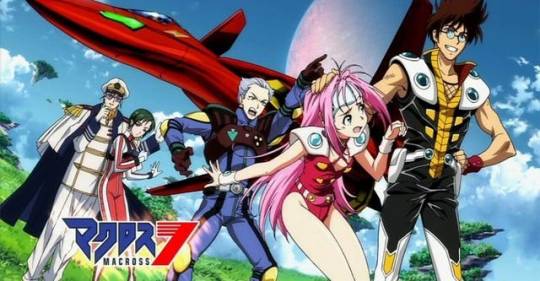
I've just started watching Macross 7...
If I understand correctly this is a direct continuation of the Super Dimension Fortress Macross storyline, and a sequel to Macross Plus. So I think I'm watching these things in the right order.
Right off the bat I like how they're emphasizing the musical aspect by starting the series with a band playing a show.
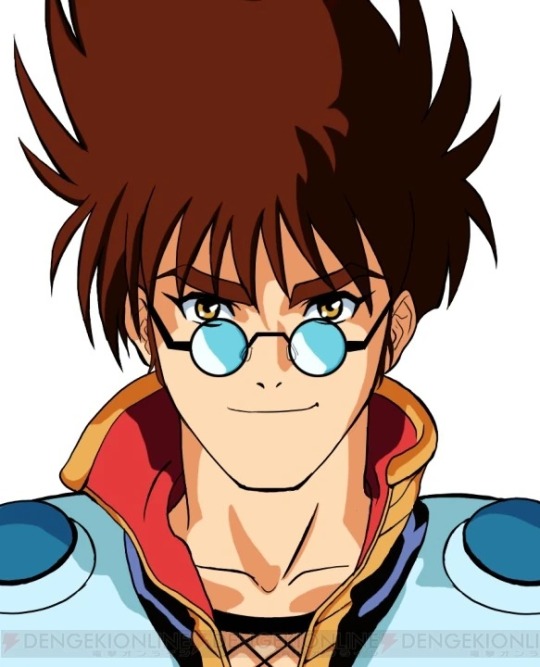
I don't know who any of the characters are yet. Don't know what role they're going to play. But the guy with the little round glasses - Basara - seems like a bit of an asshole.
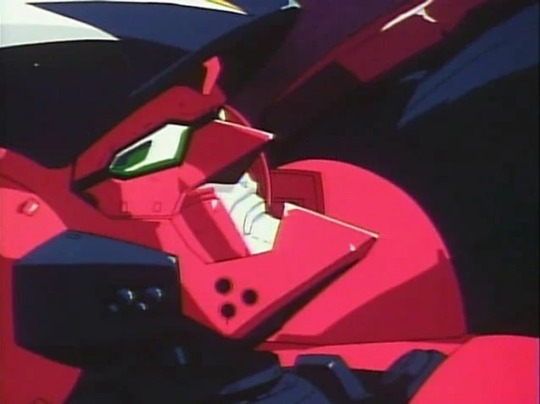
And I can't say I like his fighter actually having a face/mouth. I get it. He's a singer. His fighter has a mouth because he's singing. And I kind of love the idea of this guy riding into battle with nothing but his guitar. But the mouth just looks weird.
I also kind of love how they directly call-out the whole "power of music" thing right in this first episode.
Anyway - episode 1 is a decent start. We get a bit of an exposition dump at the beginning... We get a recap of the events of SDF Macross and we're told that now humanity is sending out colony ships across the galaxy. We're going to be following a specific ship - the Macross 7 (hence the name). We've got a bunch of interesting characters on the screen. Some hints at some relationships/dynamics that we'll hopefully explore. There's a big, one-sided fight where humanity is clearly out-gunned. An interesting, mysterious antagonist is introduced and we've got no idea who they are or what they're looking for.
I'm eager to see where this goes.
3 notes
·
View notes